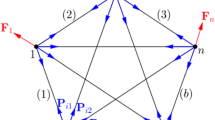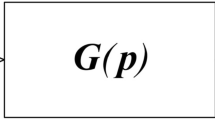Abstract
This paper deals with the applications of stochastic spectral methods for structural topology optimization in the presence of uncertainties. A non-intrusive polynomial chaos expansion is integrated into a topology optimization algorithm to calculate low-order statistical moments of the mechanical–mathematical model response. This procedure, known as robust topology optimization, can optimize the mean of the compliance while simultaneously minimizing its standard deviation. In order to address possible variabilities in the loads applied to the mechanical system of interest, magnitude and direction of the external forces are assumed to be uncertain. In this probabilistic framework, forces are described as a random field or a set of random variables. Representation of the random objects and propagation of load uncertainties through the model are efficiently done through Karhunen–Loève and polynomial chaos expansions. We take advantage of using polygonal elements, which have been shown to be effective in suppressing checkerboard patterns and reducing mesh dependency in the solution of topology optimization problems. Accuracy and applicability of the proposed methodology are demonstrated by means of several topology optimization examples. The obtained results, which are in excellent agreement with reference solutions computed via Monte Carlo method, show that load uncertainties play an important role in optimal design of structural systems, so that they must be taken into account to ensure a reliable optimization process.

(adapted from [8])












Similar content being viewed by others
Notes
These numerical realizations are defined in a computational mesh \({\textbf{x}}_1,{\textbf{x}}_2,\ldots ,{\textbf{x}}_n\).
References
Andreasen CS, Sigmund O (2013) Topology optimization of fluid–structure-interaction problems in poroelasticity. Comput Methods Appl Mech Eng 258:55–62. https://doi.org/10.1016/j.cma.2013.02.007
Antonietti P, Bruggi M, Scacchi S, Verani M (2017) On the virtual element method for topology optimization on polygonal meshes: a numerical study. Comput Math Appl 74(5):1091–1109. https://doi.org/10.1016/j.camwa.2017.05.025 (SI: SDS2016—Methods for PDEs)
Asadpoure A, Tootkabonia M, Guest J (2011) Robust topology optimization of structures with uncertainties in stiffness—application to truss structures. Comput Struct 89:1031–1041. https://doi.org/10.1016/j.compstruc.2010.11.004
Atkinson KE (2009) The numerical solution of integral equations of the second kind, reissue edn. Cambridge University Press, Cambridge
Banichuk N, Neittaanmäki P (2010) Structural optimization with uncertainties. Springer, Dordrecht
Bellizzi S, Sampaio R (2012) Smooth decomposition of random fields. J Sound Vib 331:3509–3520. https://doi.org/10.1016/j.jsv.2012.03.030
Bendsøe MP, Kikuchi N (1988) Generating optimal topologies in structural design using a homogenization method. Comput Methods Appl Mech Eng 71:197–224
Bendsøe MP, Sigmund O (2004) Topology optimization: theory, methods, and applications. Springer, Berlin
Betz W, Papaioannou I, Straub D (2014) Numerical methods for the discretization of random fields by means of the Karhunen–Loève expansion. Comput Methods Appl Mech Eng 271:109–129. https://doi.org/10.1016/j.cma.2013.12.010
Beyer HG, Sendhoff B (2007) Robust optimization—a comprehensive survey. Comput Methods Appl Mech Eng 196:3190–3218. https://doi.org/10.1016/j.cma.2007.03.003
Birge J, Louveaux F (2011) Introduction to stochastic programming. Springer, New York
Brezis H (2010) Functional analysis, Sobolev spaces and partial differential equations. Springer, New York
Bruggi M (2008) On the solution of the checkerboard problem in mixed-FEM topology optimization. Comput Struct 86:1819–1829. https://doi.org/10.1016/j.compstruc.2008.04.008
Chen S, Chen W, Lee S (2010) Level set based robust shape and topology optimization under random field uncertainties. Struct Multidiscip Optim 41:507–524. https://doi.org/10.1007/s00158-009-0449-2
Ciarlet PG (2013) Linear and nonlinear functional analysis with applications. SIAM, Philadelphia
da Silva G, Cardoso E (2017) Stress-based topology optimization of continuum structures under uncertainties. Comput Methods Appl Mech Eng 313:647–672. https://doi.org/10.1016/j.cma.2016.09.049
Dapogny C, Faure A, Michailidis G, Allaire G, Couvelas A, Estevez R (2017) Geometric constraints for shape and topology optimization in architectural design. Comput Mech 59:933–965. https://doi.org/10.1007/s00466-017-1383-6
Doltsinis I, Kang Z (2004) Robust design of structures using optimization methods. Comput Methods Appl Mech Eng 193(23):2221–2237. https://doi.org/10.1016/j.cma.2003.12.055
Duan XB, Li FF, Qin XQ (2015) Adaptive mesh method for topology optimization of fluid flow. Appl Math Lett 44:40–44. https://doi.org/10.1016/j.aml.2014.12.016
Dunning PD, Kim HA (2013) Robust topology optimization: minimization of expected and variance of compliance. AIAA J 51:2656–2664. https://doi.org/10.2514/1.J052183
Eldred M (2009) Recent advances in non-intrusive polynomial chaos and stochastic collocation methods for uncertainty analysis and design. In: 50th AIAA/ASME/ASCE/AHS/ASC Structures, Structural Dynamics, and Materials Conference. https://doi.org/10.2514/6.2009-2274
Ghanem R (1999) Ingredients for a general purpose stochastic finite elements implementation. Comput Methods Appl Mech Eng 168:19–34. https://doi.org/10.1016/S0045-7825(98)00106-6
Ghanem R, Red-Horse J (2017) Polynomial chaos: modeling, estimation, and approximation. Springer, Berlin, pp 521–551
Ghanem RG, Spanos PD (2003) Stochastic finite elements: a spectral approach, 2nd edn. Dover, New York
Guest JK, Igusa T (2008) Structural optimization under uncertain loads and nodal locations. Comput Methods Appl Mech Eng 198:116–124. https://doi.org/10.1016/j.cma.2008.04.009
Hoshina TYS, Menezes IFM, Pereira A (2018) A simple adaptive mesh refinement scheme for topology optimization using polygonal meshes. J Braz Soc Mech Sci Eng 40(7):348. https://doi.org/10.1007/s40430-018-1267-5
Jalalpour M, Guest JK, Igusa T (2013) Reliability-based topology optimization of trusses with stochastic stiffness. Struct Saf 43:41–49. https://doi.org/10.1016/j.strusafe.2013.02.003
Keshavarzzadeh V, Fernandez F, Tortorelli DA (2017) Topology optimization under uncertainty via non-intrusive polynomial chaos expansion. Comput Methods Appl Mech Eng 318:120–147. https://doi.org/10.1016/j.cma.2017.01.019
Kim NH, Wang H, Queipo NV (2006) Efficient shape optimization under uncertainty using polynomial chaos expansions and local sensitivities. AIAA J 44:1112–1116. https://doi.org/10.2514/1.13011
Kroese DP, Taimre T, Botev ZI (2011) Handbook of Monte Carlo methods. Wiley, London
Kundu A, Adhikari S, Friswell M (2014) Stochastic finite elements of discretely parameterized random systems on domains with boundary uncertainty. Int J Numer Methods Eng 100(3):183–221
Kundu A, Matthies H, Friswell M (2018) Probabilistic optimization of engineering system with prescribed target design in a reduced parameter space. Comput Methods Appl Mech Eng 337:281–304
Luo Y, Niu Y, Li M, Kang Z (2017) A multi-material topology optimization approach for wrinkle-free design of cable-suspended membrane structures. Comput Mech 59:967–980. https://doi.org/10.1007/s00466-017-1387-2
Maître OPL, Knio OM (2010) Spectral methods for uncertainty quantification: with applications to computational fluid dynamics. Springer, Dordrecht
Michell MCE (1904) LVIII. The limits of economy of material in frame-structures. Lond Edinb Dublin Philos Mag J Sci 8:589–597. https://doi.org/10.1080/14786440409463229
Nanthakumar SS, Valizadeh N, Park HS, Rabczuk T (2015) Surface effects on shape and topology optimization of nanostructures. Comput Mech 56:97–112. https://doi.org/10.1007/s00466-015-1159-9
Nguyen-Xuan H (2017) A polytree-based adaptive polygonal finite element method for topology optimization. Int J Numer Methods Eng 110(10):972–1000. https://doi.org/10.1002/nme.5448
Park J, Sutradhar A, Shah JJ, Paulino GH (2018) Design of complex bone internal structure using topology optimization with perimeter control. Comput Biol Med. https://doi.org/10.1016/j.compbiomed.2018.01.001
Pereira A, Talischi C, Paulino GH, Menezes IFM, Carvalho MS (2016) Fluid flow topology optimization in polytop: stability and computational implementation. Struct Multidiscip Optim 54:1345–1364. https://doi.org/10.1007/s00158-014-1182-z
Perrin G, Soize C, Duhamel D, Funfschilling C (2013) Karhunen–Loève expansion revisited for vector-valued random fields: scaling, errors and optimal basis. J Comput Phys 242:607–622. https://doi.org/10.1016/j.jcp.2013.02.036
Pettersson MP, Iaccarino G, Nordström J (2015) Polynomial chaos methods for hyperbolic partial differential equations: numerical techniques for fluid dynamics problems in the presence of uncertainties. Springer, Berlin
Putek P, Pulch R, Bartel A, ter Maten EJW, Günther M, Gawrylczyk KM (2016) Shape and topology optimization of a permanent-magnet machine under uncertainties. J Math Ind 6:11. https://doi.org/10.1186/s13362-016-0032-6
Qizhi Q, Kang Z, Wang Y (2014) A topology optimization method for geometrically nonlinear structures with meshless analysis and independent density field interpolation. Comput Mech 54:629–644. https://doi.org/10.1007/s00466-014-1011-7
Richardson J, Filomeno Coelho R, Adriaenssens S (2016) A unified stochastic framework for robust topology optimization of continuum and truss-like structures. Eng Optim 48:334–350. https://doi.org/10.1080/0305215X.2015.1011152
Romero JS, Silva ECN (2014) A topology optimization approach applied to laminar flow machine rotor design. Comput Methods Appl Mech Eng 279:268–300. https://doi.org/10.1016/j.cma.2014.06.029
Rubinstein RY, Kroese DP (2016) Simulation and the Monte Carlo method, 3rd edn. Wiley, London
Shin S, Samanlioglu F, Cho BR, Wiecek MM (2011) Computing trade-offs in robust design: perspectives of the mean squared error. Comput Ind Eng 60:248–255. https://doi.org/10.1016/j.cie.2010.11.006
Sigmund O, Petersson J (1998) Numerical instabilities in topology optimization: a survey on procedures dealing with checkerboards, mesh-dependencies and local minima. Struct Optim 16:68–75. https://doi.org/10.1007/BF01214002
Soize C (2013) Stochastic modeling of uncertainties in computational structural dynamics—recent theoretical advances. J Sound Vib 332:2379–2395. https://doi.org/10.1016/j.jsv.2011.10.010
Soize C (2015) Polynomial chaos expansion of a multimodal random vector. SIAM/ASA J Uncertain Quantif 3:34–60. https://doi.org/10.1137/140968495
Soize C (2017) Uncertainty quantification: an accelerated course with advanced applications in computational engineering. Springer, Berlin
Soize C, Desceliers C (2010) Computational aspects for constructing realizations of polynomial chaos in high dimension. SIAM J Sci Comput 32:2820–2831. https://doi.org/10.1137/100787830
Soize C, Ghanem R (2004) Physical systems with random uncertainties: chaos representations with arbitrary probability measure. SIAM J Sci Comput 26:395–410. https://doi.org/10.1137/S1064827503424505
Soize C, Ghanem R (2017) Polynomial chaos representation of databases on manifolds. J Comput Phys 335:201–221. https://doi.org/10.1016/j.jcp.2017.01.031
Spanos PD, Ghanem R (1989) Stochastic finite element expansion for random media. J Eng Mech 115:1035–1053. https://doi.org/10.1061/(ASCE)0733-9399(1989)115:5(1035)
Stefanou G (2009) The stochastic finite element method: past, present and future. Comput Methods Appl Mech Eng 198:1031–1051. https://doi.org/10.1016/j.cma.2008.11.007
Svanberg K (1987) The method of moving asymptotes—a new method for structural optimization. Int J Numer Methods Eng 24:359–373. https://doi.org/10.1002/nme.1620240207
Talischi C, Paulino GH, Pereira A, Menezes IFM (2010) Polygonal finite elements for topology optimization: a unifying paradigm. Int J Numer Methods Eng 82:671–698. https://doi.org/10.1002/nme.2763
Talischi C, Paulino GH, Pereira A, Menezes IFM (2012) PolyTop: a Matlab implementation of a general topology optimization framework using unstructured polygonal finite element meshes. Struct Multidiscip Optim 45:329–357. https://doi.org/10.1007/s00158-011-0696-x
Tootkaboni M, Asadpoure A, Guest JK (2012) Topology optimization of continuum structures under uncertainty—a polynomial chaos approach. Comput Methods Appl Mech Eng 201–204:263–275. https://doi.org/10.1016/j.cma.2011.09.009
Wu J, Gao J, Luo Z, Brown T (2016) Robust topology optimization for structures under interval uncertainty. Adv Eng Softw 96:36–48. https://doi.org/10.1016/j.advengsoft.2016.05.002
Xia L, Da D, Yvonnet J (2018) Topology optimization for maximizing the fracture resistance of quasi-brittle composites. Comput Methods Appl Mech Eng 332:234–254. https://doi.org/10.1016/j.cma.2017.12.021
Xiu D (2010) Numerical methods for stochastic computations: a spectral method approach. Princeton University Press, Princeton
Xiu D, Karniadakis GE (2002) The Wiener–Askey polynomial chaos for stochastic differential equations. SIAM J Sci Comput 24:619–644. https://doi.org/10.1137/S1064827501387826
Zhang W, Kang Z (2017) Robust shape and topology optimization considering geometric uncertainties with stochastic level set perturbation. Int J Numer Methods Eng 110:31–56. https://doi.org/10.1002/nme.5344
Zhang XS, de Sturler E, Paulino GH (2017) Stochastic sampling for deterministic structural topology optimization with many load cases: density-based and ground structure approaches. Comput Methods Appl Mech Eng 325:463–487. https://doi.org/10.1016/j.cma.2017.06.035
Zhang XS, Paulino GH, Ramos AS (2018) Multi-material topology optimization with multiple volume constraints: a general approach applied to ground structures with material nonlinearity. Struct Multidiscip Optim 57:161–182. https://doi.org/10.1007/s00158-017-1768-3
Zhao J, Wang C (2014) Robust structural topology optimization under random field loading uncertainty. Struct Multidiscip Optim 50:517–522. https://doi.org/10.1007/s00158-014-1119-6
Acknowledgements
NC acknowledges the financial support from the Group of Technology in Computer Graphics (Tecgraf/PUC-Rio), Rio de Janeiro, Brazil. AP and IFMM acknowledge the financial support from the National Council for Scientific and Technological Development (CNPq) under projects 312280/2015-7 and 309708/2015-0, respectively. AP and ACJr are thankful for the support from Carlos Chagas Filho Research Foundation of Rio de Janeiro State (FAPERJ) under grants E-26/203.189/2016, E-26/010.002.178/2015 and E-26/010.000.805/2018. The information provided in this paper is the sole opinion of the authors and does not necessarily reflect the views of the sponsoring agencies..
Author information
Authors and Affiliations
Corresponding author
Additional information
Technical Editor: Paulo de Tarso Rocha de Mendonça, Ph.D.
Rights and permissions
About this article
Cite this article
Cuellar, N., Pereira, A., Menezes, I.F.M. et al. Non-intrusive polynomial chaos expansion for topology optimization using polygonal meshes. J Braz. Soc. Mech. Sci. Eng. 40, 561 (2018). https://doi.org/10.1007/s40430-018-1464-2
Received:
Accepted:
Published:
DOI: https://doi.org/10.1007/s40430-018-1464-2




